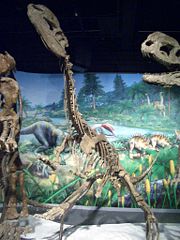Dilophosaurus
2008/9 Schools Wikipedia Selection. Related subjects: Dinosaurs
| Dilophosaurus Fossil range: Early Jurassic |
||||||||||||||||
|---|---|---|---|---|---|---|---|---|---|---|---|---|---|---|---|---|
 Reconstruction of Dilophosaurus wetherelli
|
||||||||||||||||
| Scientific classification | ||||||||||||||||
|
||||||||||||||||
| Species | ||||||||||||||||
|
D. wetherelli (Welles, 1954 [originally Megalosaurus wetherelli]) ( type) |
Dilophosaurus was a theropod dinosaur from the Early Jurassic Period. The name (pronounced /daɪˌlɒfəˈsɔrəs/ ("dy-LOH-fo-sawr-us") means 'two-crested lizard', because the animal had two crests (Greek di meaning 'two', lophos meaning 'crest' and sauros meaning 'lizard'). The first specimens were described in 1954, but it was not until over a decade later that the genus received its current name. Dilophosaurus is one of the earliest known Jurassic theropods, but also one of the least understood.
Dilophosaurus has appeared several times in popular culture, most prominently as the imaginatively-interpreted creature that kills and eats Dennis Nedry in Jurassic Park.
Description and taxonomy
Dilophosaurus measured around six meters (20 ft) long and may have weighed half a ton. It lived in the Early Jurassic Period. Dilophosaurus discoverer Sam Welles later redescribed the entire taxon in 1984, in a more comprehensive paper. Dilophosaurus may be a primitive member of the clade containing both ceratosaurian and tetanuran theropods. Alternatively, some paleontologists classify this genus as a large coelophysoid.
The most distinctive characteristic of Dilophosaurus is the pair of rounded crests on its skull, possibly used for display. Studies by Robert Gay show that these crests may have been larger in one sex than in the other. The teeth of Dilophosaurus are long, but have a fairly small base and expand basally. Another skull feature was a notch behind the first row of teeth, giving Dilophosaurus an almost crocodile-like appearance. This "notch" existed by virtue of a weak connection between the premaxillary and maxillary bones of the skull. This conformation led to the hypothesis that Dilophosaurus scavenged off dead carcasses, with the front teeth being too weak to bring down and hold large prey.
There is another species of Dilophosaurus (D. sinensis), which may or may not belong to this genus. It is possibly closer to the bizarre Antarctic theropod Cryolophosaurus, based on the fact that the anterior end of the jugal does not participate in the internal antorbital fenestra and that the maxillary tooth row is completely in front of the orbit and ends anterior to the vertical strut of the lacrimal. This species was recovered from the Yunnan Province of China in 1987, with the prosauropod Yunnanosaurus and later described and named in 1993 by Shaojin Hu.
Discovery
The first Dilophosaurus specimens were discovered by Sam Welles in the summer of 1942. The specimen was brought back to Berkeley for cleaning and mounting, where it was given the name Megalosaurus wetherilli. Returning to the same formation a decade later to determine from which time period the bones dated, Welles found a new specimen not far from the location of the previous discovery. The specimens were later renamed Dilophosaurus, based on the double crest clearly visible in the new skeleton.
Paleobiology
In popular culture
Dilophosaurus was prominently featured both in the 1993 movie Jurassic Park, and in the original novel by Michael Crichton. In the film version, Dilophosaurus has a retractable neck frill around its neck (much like a frill-necked lizard), and spits blinding poison, aiming for the eyes to blind and paralyze its prey. There is no evidence to support either the frill or the venom spitting, which was acknowledged by Crichton as creative license. In the film, Steven Spielberg also reduced the size of Dilophosaurus to 3 feet tall and 5 feet long, much smaller than it was in reality. Jurassic Park merchandise, including toys and video games (such as Jurassic Park: Operation Genesis and the arcade games The Lost World: Jurassic Park and Jurassic Park III), often include Dilophosaurus.
Despite its inaccuracies, the Jurassic Park Dilophosaurus has been taken up by others. Several other video games, such as ParaWorld and Jurassic Wars, feature Dilophosaurus modeled after the representations in Jurassic Park, and The Whitest Kids U'Know sketch "Dinosaur Rap", a music video for Trevor Moore's "Gettin' High With Dinosaurs" features a Dilophosaurs, complete with a short frill. One video game, 2008's " Turok", features Dilophosaurus based more closely on real fossils and displays their correct size. Dilophosaurus was also featured in the documentary When Dinosaurs Roamed America, killing an Anchisaurus and scaring off a pack of Syntarsus (now known as Megapnosaurus).



